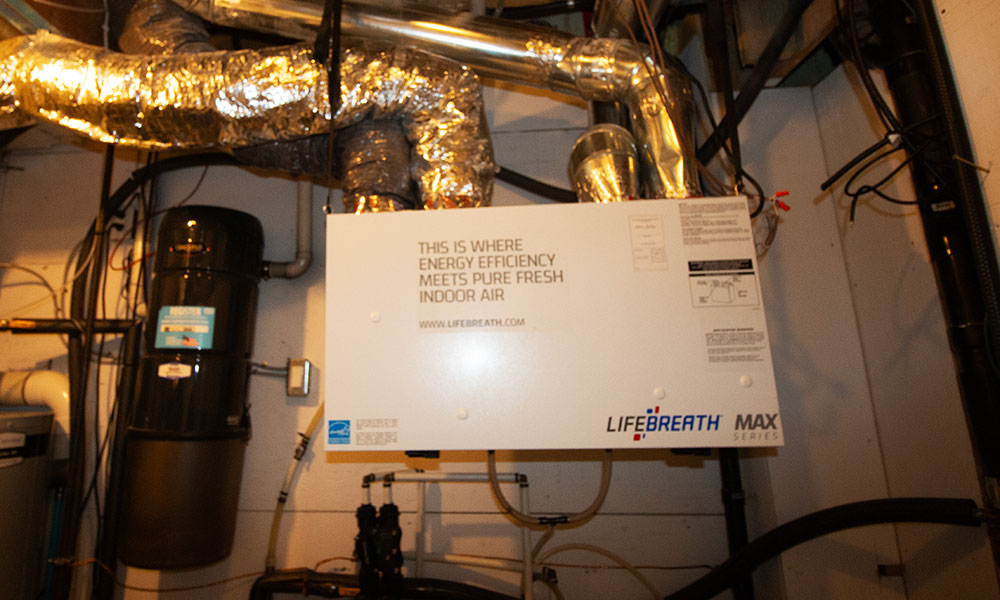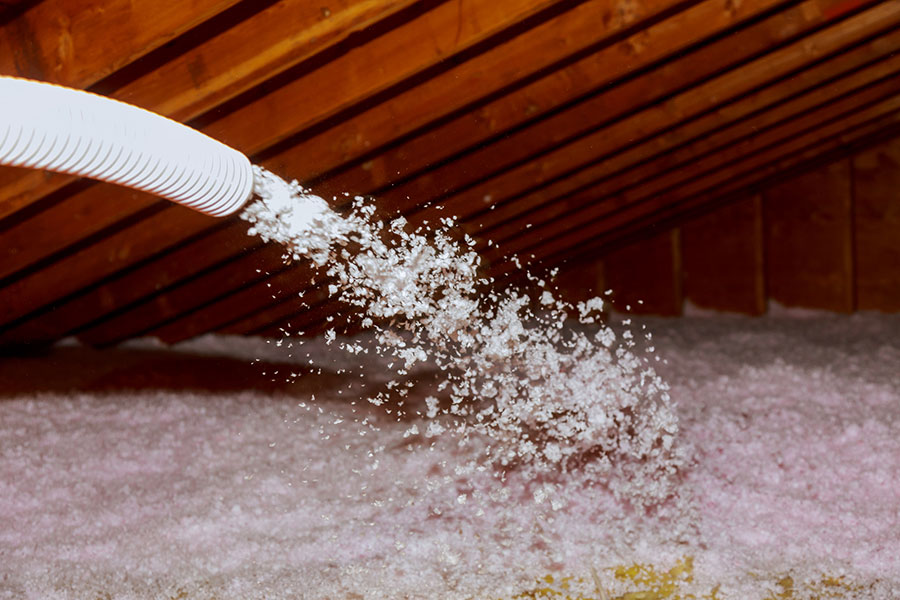Considerations for windows, heating, insulation and more
Twenty years ago, home efficiency was a harder sell, says Les Wold (Applied Banking and Business ’92), managing partner at Effect Home Builders, which focuses on producing greener homes.
 “When we started in 2001, we had to do a lot of educating.”
“When we started in 2001, we had to do a lot of educating.”
Canadians homeowners still use 11% more energy than they did back then but, according to National Resources Canada, we’d use 43% more if not for energy-efficiency improvements. And the focus on continuing to find ways to reduce that footprint is increasing.
In fact, Effect is on track to build five net-zero homes in Edmonton in 2024. “Now we’re seeing that people are seeking it out,” says Wold.
There’s no shortage of ways. But which ones might you consider to begin to combat rising electricity rates and volatile natural gas prices? To learn more, we visited Wold’s own home, built in 2018 and a stop on the 2023 Edmonton Eco-solar Home tour, to see what makes it roughly 40% more efficient than a house from a previous era.
And, to help set priorities, we’ve included footnotes courtesy of Construction Engineering Technology instructor Kenneth Williams.
“I don't want to be preachy but climate is changing,” says Wold. So are costs. Here’s how to begin to address both.

Wold’s home features a wall of windows facing the backyard and limiting the need for daytime artificial light indoors above ground.
For those looking to replace existing windows, Wold recommends gas-filled, triple-pane models, which improve upon double-pane efficiency by about 20%. Adding a low-emissive coating will further prevent heat loss in winter, as well as block incoming heat in summer.
“A lot of it comes down to what's in the frame,” Wold adds. (1) It should not contain a thermal bridge, or material that links the side facing the home and that facing the elements, creating a conduit for heat loss.
Learn more about how NAIT's Construction Engineering Technology diploma provides the fundamentals of planning and managing projects

One of Wold’s favourite efficiency features is also one of his home’s simplest. A large window looking onto a second-floor deck permits sunlight that can overheat the upper floor during the day. Therefore, the window features a retractable exterior cover. (2)
“In the summer, we’d leave the blinds down and it kept the upstairs [cool],” says Wold.
In the evening, that white cover doubled as a screen for a movie projector, bringing the family together.
Drapes work, too. (3) Those with a white plastic backing have been shown to reduce summer heat gains by a third, as well as winter losses by 10%.

Wold’s home has a programmable thermostat – a feature that, according to Statistics Canada, was built into 61% of houses across the country in 2019 (66% in Alberta). Programming them to reduce the temperature during the day when inhabitants aren’t home, or at night when asleep, can yield annual savings of at least 10%.
You might improve upon that with a smart thermostat that programs itself. “They learn your habits and then function based on that,” Wold says. (4)
A company of NAIT grads
Founded in 2001, Effect Home Builders has grown from the original team of Les Wold (Applied Banking and Business ’92), Dave Brettelle (Carpenter ’05) and Dale Rott (Carpenter '96) to a well-rounded group of designers, builders and businesspeople. Like the founders, most are NAIT grads, including
- Renée Beaulieu (Architectural Technology ’22)
- William Berger (Carpenter ’15)
- Kurtis Brown (Carpenter ’22)
- Dominic Emmelkamp (Carpenter '09)
- Nick Harrington (Carpenter ’16)
- Zach Kirinic (Carpenter ’23, Millwork & Carpentry Certificate ’20)
- Reuben Noot (Architectural Technology ’23, Carpenter ’22)
- Scott Wilson (Architectural Technology ’07)

Being nearly airtight, an efficient home needs fresh air year-round. Fresh air, however, is very cold in the winter, pushing the furnace to bring it from perhaps -20 C to more than 20 C. A heat recovery ventilator cuts the spread, recovering as much as 85% of energy from exhaust air. (5)
“It extracts heat from the indoor air [leaving your house] and preheats the air coming in,” says Wold. “In an efficient way, it keeps the air fresh in the home.” (6)
 Similar to a heat recovery ventilator, drain water heat recovery extracts warmth from water exiting your home and uses it to preheat water headed for the hot water tank. (7)
Similar to a heat recovery ventilator, drain water heat recovery extracts warmth from water exiting your home and uses it to preheat water headed for the hot water tank. (7)
This is accomplished by a simple copper pipe coiled around the drain stack.
“It’s not overly expensive, it has no moving parts, it’s maintenance free,” says Wold.
 Water in Edmonton is “moderately hard,” according to Epcor, the city’s water utility.
Water in Edmonton is “moderately hard,” according to Epcor, the city’s water utility.
That means it contains minerals, such as calcium, that can build up and lead to problems. Residue in a hot water tank can lower its efficiency, for example, as well as send appliances, such as washing machines and dishwashers, to the landfill prematurely.
Wold has a water softener installed at the earliest point in his plumbing system to help extend appliance life. (8)

As the cost of electricity is going up, the cost of solar modules is coming down, Wold points out.
"A system installed by Effect today, for example, would cost about half of what a similar system installed in 2012 would have cost," he says.
“And the modules are even more efficient.” (9)
Wold’s home is topped by a 5.76-kilowatt photovoltaic system capable of producing more than 9,200 kW per year. The average Alberta home consumes about 7,200 kW per year.
High-efficiency furnace

Like all modern builds, Wold’s home features a high-efficiency furnace, which converts at least 90% of fuel to heat.
Upgrading from an original furnace (50% to 60% efficient) can reduce greenhouse gas emissions by more than one tonne annually, and save on fuel costs.
Related: Will heat pumps work in Alberta?

Most homeowners won’t be able to match the insulation of the walls in Wold’s home.
In the basement and on the first floor, insulating concrete forms – cement between two layers of insulating material – offer an R value (or resistance to heat loss) of 24; on the second floor, another type of advanced wall system brings that to 30.
In contrast, the walls of a home from a previous era might achieve R15. (10)
Savings will be more easily realized above the ceiling. A 2017 study found that 49% of all retrofit potential for increasing Canadian home efficiency lay in improved attic insulation. In Alberta, shoot for R49 to R60 recommends one guide, or 12 to 14 inches, depending on the material. (11)
The attic in Wold’s home is rated R50.

The railing lining Wold’s second-floor deck looks like wood – tan coloured, with a visible grain – but it’s actually a more durable composite material that he likely won’t need to replace.
“It never needs to be stained,” says Wold.
In that case, the implications for efficiency are two-fold. One, there are no short-lived materials that will need to be regularly replaced. Two, there are savings of another kind: the effort and energy of the homeowner, ensuring more hours spent simply enjoying the house.
“That’s also a consideration,” says Wold. “How much maintenance are you putting into the home?” (12)
(1) Williams also champions high-quality windows but notes that they can be undermined by bad installation. “The biggest thing is making sure that the perimeter of the windows is properly sealed,” he says. (Back)
Related: How to reduce heat loss from your home
(2) A solar shade above the windows, or a grill correctly angled against the midday summer sun, is a less expensive option, says Williams. In the winter, snow will pass through it, as will warming light from the lower-sitting sun. “It's easy enough to design for Edmonton.” (Back)
(3) Place the coverings far enough from the window surface to allow airflow, says Williams. This will limit condensation in winter. (Back)
(4) “At the very least, I would suggest the programmable [thermostat],” says Williams. (Back)
(5) An HRV has the added benefit of decreasing home humidity – a challenge in winter – by exahusting moisture outside rather than allowing it to be circulated throughout the home, says Williams. (Back)
(6) Using an HRV leads to “a big energy savings,” says Williams. “It's a good idea to have one.” (Back)
(7) “It's an old technology,” says Williams, but using water to heat water in this way is highly efficient. (Back)
(8) Williams leaves the value of a water softener to the homeowner’s discretion – at least with respect to preserving machines. Chances are good, he feels, that they’ll be swapped out before being compromised by hard-water mineral deposits. “Everybody changed out their avocado-green appliances long before they started to fail,” he says. (Back)
(9) In designing his own home, Williams set the roof pitch for optimal solar power generation via photovoltaic modules. He has put off installation, hesitating due to a purported lifespan of 25 years and concerns over the recycling of panels. Nonetheless, he says, “Ultimately, we need to transition away from our reliance on fossil fuels.” (Back)
(10) The efficiency of exterior walls, Williams points out, can be improved with a layer of ½- to 1-inch thick rigid insulation on the outside before reapplying cladding. “That also gives you the opportunity to make sure that all windows and openings are well sealed.” (Back)
(11) “But pay attention to the soffits” when insulating, Williams warns. Ensure that air can enter from the eaves and circulate up and out near the ridgeline, keeping the space cold and preventing issues such as ice dams. (Back)
(12) In addition to efficiency, “Everybody wants convenience,” says Williams. “What's more convenient than not having to spend a couple of days in the summer refinishing a deck?” (Back)